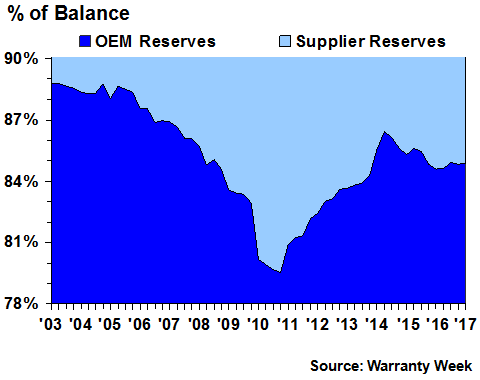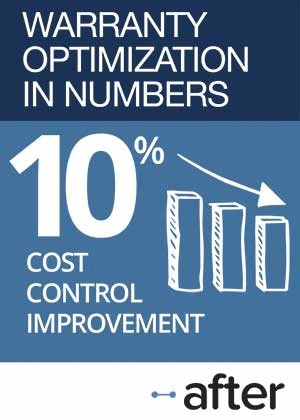Automotive Supplier Recoveries:A decade ago, the largest OEMs devised new warranty policies that helped to shift more of their expenses back to their suppliers. But then in 2014, an increasing number of safety recalls raised their warranty cost back up, leaving both them and their suppliers at higher expense levels.
In the U.S.-based automotive industry, increased supplier recovery efforts began to show results a decade ago, reducing warranty expense rates for OEMs and raising them for suppliers. But in the last few years, an increased number of large-scale safety recalls have raised the rates back up for the OEMs, leaving both groups with elevated expense rates.
To reach this conclusion, as we did back in the August 25, 2016 newsletter, we selected 55 automotive OEMs and 122 automotive parts and component suppliers to evaluate. They include not only most of the U.S.-based passenger car industry, but also most of the truck and heavy equipment industry, as well as motorcycles, forklifts, and other vocational vehicles.
We're not including Chrysler, because its warranty expenses are now reported along with Fiat's, so we'll deal with them in a European automotive warranty report. However, from 2009 until 2015, the American unit of the company did report separately, because it had a duty to report thanks to some bonds the company sold to investors. But when those bonds were redeemed, the separate reporting ceased. If we were to include the Chrysler data we have, it would skew the findings even further towards the OEMs.
Three Different Measurements
To illustrate the ebb and flow of OEM and supplier warranty costs, what we're going to do is to display the same claims and accrual data in three different ways. First, we're going to present automotive claims paid and accruals made by the OEMs and suppliers in the form of quarterly totals, in millions of dollars. Second, we're going to take those totals and divide them by the corresponding automotive product revenue, calculating what percentage of sales the claims and accrual totals represent. And third, we're going to figure out what share of the 100% total is OEM, and what share is supplier, during each of the past 57 quarters.
Let's start with the raw dollar counts. In the first quarter of 2017, the OEMs paid $2.522 billion in claims, an increase of $14 million from their total in the same quarter of 2016. Suppliers, meanwhile, paid $463 million in claims in the first quarter of 2017, up $33 million from year-ago levels.
Figure 1
Automotive Product Warranties
Claims Paid by U.S.-based Companies
(quarterly totals in US$m, 2003-2017)
In all of calendar 2016, the OEMs paid $10.379 billion in claims, up by $154 million from 2015 levels. Suppliers paid $1.762 billion in claims last year, up by $67 million from 2015 levels.
We delved into the specifics for many of the individual companies in the March 30 newsletter, so we won't repeat it here. But in summary, on the OEM side the biggest increases in claims payments were reported by Ford Motor Co., Polaris Industries Inc., Tesla Inc., and Thor Industries Inc. The biggest declines in OEM claims payments were reported by Joy Global Inc., Paccar Inc., Manitowoc Company Inc., and Terex Corp.
On the supplier side, the biggest increases were reported by BorgWarner Inc., Delphi Automotive, Wabco Holdings Inc., and Westinghouse Air Brake Technologies Corp. The biggest decreases in claims payments were reported by Cummins Inc., LKQ Corp., and Goodyear Tire & Rubber Co.
Note that we're looking only at the dollar totals for claims paid, without correlating it with sales. Therefore, it may be perfectly OK for a company like Tesla to see claims payments soar by 50%. Its sales rose by 126%, so the additional cost was more than covered. The trouble comes when sales declined, as they did for Polaris, or didn't grow as fast as expenses, as was the case at Ford.
Warranty Accrual Totals
Warranty accruals are perhaps even more revealing, because they signal what a company believes will happen, as opposed to claims, which show what actually happened. When companies expect to see claims rising, they first increase accruals. And when they expect to see sales falling, they allow accruals to also decline, simply by keeping them proportional to sales. If they accrued $500 per vehicle during the boom years, they would still accrue $500 per vehicle during the slow years. But they'd sell fewer vehicles.
In Figure 2 we're tracking the quarterly accrual totals for the 55 OEMs and 122 suppliers. In the first quarter of 2017, the OEMs accrued $2.26 billion while the suppliers accrued $441 million. That represented a year-over-year increase of $214 million for the OEMs and $20 million for the suppliers.
For all of calendar 2016, the OEMs accrued $8.975 billion, an increase of $370 million from 2015 levels. The suppliers, meanwhile, actually reduced their accruals by $31 million, from $1.765 billion in 2015 to $1.734 billion in 2016.
Figure 2
Automotive Product Warranties
Accruals Made by U.S.-based Companies
(quarterly totals in US$m, 2003-2017)
Notice that while the suppliers usually keep their accrual levels close to their claims totals, many of the OEMs tend to accrue far less than they actually spend. For instance, last year Ford accrued $960 million less than it paid in claims. Navistar accrued $256 million less than it paid in claims. And GM accrued $176 million less than it paid in claims. These deficits tend to be filled through changes in estimate, which we're not including here in these totals.
However, there are numerous companies that make larger accruals than they pay in claims. For instance, Tesla does so because its sales are rising so fast. Polaris does so because it anticipates higher claims payments in the future due to safety recalls.
Warranty Expense Rates
In Figure 3, we've taken the raw quarterly dollar totals from Figures 1 and 2 and divided them by corresponding product sales totals, to calculate two pairs of warranty expense rates, for the claims and accrual rates of the OEMs, and for the suppliers. Note that there is a gap between them, which over the years has varied from roughly two percent in 2003 and 2004, to one percent in 2009 and 2010, before moderating back to roughly 1.5% in recent years.
Figure 3
Automotive Product Warranties
Average Warranty Claims & Accrual Rates
(as a % of product sales, 2003-2017)
There are two notable spikes in the data. In 2009, the OEMs saw their claims rates spike, but this was almost entirely due to a massive decline in sales. While fewer new vehicles were sold, lots of old vehicles still needed warranty work. In fact, recessionary fears may have prompted some vehicle owners to file more claims and "get their money's worth," further driving up claims rates.
And then in 2014, the OEMs' accrual rate spiked. This was almost entirely due to the safety recalls that GM and others faced at that time. Anticipating the higher expenses ahead, they set aside additional funds, which were spent in subsequent quarters, as is suggested by the rising claims rates of 2014-17.
OEMs Always Pay More?
But over the long term, what this chart is telling us is that the OEMs always pay higher expense rates than their suppliers. Is it because the OEMs face the end user customers while the suppliers face other manufacturers? Is it because the cost of claims, especially the labor costs, are difficult for the OEMs to pass onto their suppliers? Or is it because the OEMs are not as efficient as they could be when it comes time to pass expenses back to the manufacturers who produced the defects?
It's hard to say why there's such a difference in expense rates between the companies that make the parts and the companies that sell the vehicles. But it's clear that there is a difference. And it's also clear that it hasn't been static over time.
Anecdotally, Warranty Week readers have said that following the recent recession, the OEMs made a concerted effort to recover a larger share of their warranty expenses from their suppliers. That would help explain the narrowing of the gap in the middle years. And then the recall expenses would explain the widening of the gap again in 2014. But what explains the recent narrowing?
In the first quarter of 2017, OEMs spent 2.3% of their revenue on claims while suppliers spent 0.8%. The OEMs set aside 2.0% of their revenue as accruals, while the suppliers set aside 0.8%. So depending on the metric, the gap stands at either 1.3% or 1.5%.
Long term, the OEMs' average claims rate has been around 2.4%, while their average accrual rate has been 2.2%. During the past few years both metrics have tended to be slightly below that long-term average, though in four of the last 12 quarters their claims rate was slightly above average.
Meanwhile, the suppliers haven't put 0.8% of their revenue towards claims since early 2010. And they've been above average for all four of the most recent quarters. In fact, their accrual rate hasn't been this high since the middle of 2009. But because the OEMs are also currently suffering from elevated expense rates, the gap is not widening.
Share of Warranty Expenses
Let's look at these expenses another way. Let's assume that the U.S. automotive market is 100% represented by these 55 OEMs and 122 suppliers. It's not, of course, because there are international OEMs such as Toyota, VW and Volvo Trucks, as well as international suppliers such as Autoliv, Magna, and Robert Bosch. Also, many of these U.S.-based companies are exporters, selling in China and Europe, as well as in Canada and Mexico.
So it is not a closed market. But let's assume that the claims and accrual totals reported by these 55 OEMs and 122 suppliers represent 100% of the automotive industry's claims and accruals. What are their respective shares of that total over time?
In Figure 4, we've taken the dollar totals for claims paid from Figure 1, and converted them into a percentage scale. In other words, the $2.522 billion paid by the OEMs in the first quarter of 2017 represented 84.5% of the overall total, while the $463 million paid by suppliers represented the remaining 15.5%.
Figure 4
Automotive Product Warranties
Claims Paid by U.S.-based Companies
(as a percent of the total, 2003-2017)
Over the past 14 years, the average share paid by the OEMs has been a little than that, while the suppliers' share has been a little lower. But the extremes have been ever farther apart. In 2004, the OEMs briefly paid 90% of the total. In 2012 they almost hit 80%. In 2014 it was briefly back to 89%.
What we're suggesting is that it didn't happen by chance. After the recession struck in 2008, OEMs made a concerted effort to recover more of their warranty expenses from their suppliers. And they were largely successful, until the increasing rate of recalls overwhelmed that success. Now, both the OEMs and suppliers are left with higher expense rates.
Accrual Shares
We see a similar pattern in Figure 5, which measures accrual shares, though the extremes are a little wider and the timing is a little earlier. Back in 2004 the OEMs briefly made almost 91% of the total industry accruals, and in 2009 their share briefly dropped below 77%.
In the first quarter of 2017, the OEMs made 83.7% of the total industry accruals, slightly below the long-term average but very close to the trend for the past six years (excepting the recall-related spike of 2014).
Figure 5
Automotive Product Warranties
Accruals Made by U.S.-based Companies
(as a percent of the total, 2003-2017)
The scale is exaggerated in Figures 4 and 5 in order to show the detail in the changing shares. But they both describe a time period that can be split in three: 1) before the recession, 2) before the recall spike, and 3) after the recalls. And they are marked by 1) highest OEM warranty expenses, 2) lowest OEM warranty expenses, and 3) somewhere in the middle.
All we have is anecdotal evidence, but we would suggest that the reason for 2) is an increased effort by OEMs to recover more warranty expense from suppliers. And the reason for 3) is increased recalls erasing some of those gains.
We can only imagine what effect the inclusion of imports and transplants would have on these shares, and what they would look like it we could exclude warranty expenses incurred overseas by U.S.-based providers. However, by measuring this same group of 177 companies over 14 years, we've been able to calculate some baselines, and therefore we can measure the deviations from those benchmarks.
Long-Term Trends
Over the long term, the OEMs spend roughly 2.4% of their automotive revenue on warranty claims. The average is higher for passenger cars and lower for trucks, because manufacturers such as GM and Ford provide bumper-to-bumper warranties while for trucks the engines and transmissions are usually warranted separately.
Over the long term, the OEMs account for roughly 86% of the entire industry's claims total. Their share was lower than that between 2009 and 2014, but was higher both before and after that five-year period.
Over the long term, automotive suppliers spend roughly 0.6% of their revenue on warranty claims. That average is higher for powertrain suppliers, and lower for components such as brakes and interiors. For some reason, it's also higher for aftermarket parts suppliers, but we'll leave that question to be answered at another time.
Lately, the suppliers have been paying higher-than-average claims rates, with their early 2017 expense rates the highest they've been in seven or eight years.
And finally, over the long term the suppliers have accounted for roughly 14% of the entire industry's claims total. Their share of accruals is slightly higher, because some of the OEMs seem to prefer to make course-correcting accruals after the fact rather than making sufficient accruals at the time of sale. Suppliers tend to keep their claims and accrual rates closer together.
Warranty Reserves
Admittedly, the trend is a bit difficult to spot in the charts above, because there is a lot of variance in the measurements, with jagged spikes as the numbers go back and forth from one quarter to the next. We'll leave you with a chart that follows the share of funds in the warranty reserves of the 55 OEMs and 122 suppliers, which shows the trend very cleanly.
Figure 6
Automotive Product Warranties
Reserves Held by U.S.-based Companies
(as a percent of the total, 2003-2017)
The reserve balance is largely the result of accruals being added and claims being subtracted from the fund. But it also reflects all those changes of estimate, acquisitions, and foreign exchange fluctuations, all of which tend to smooth the ripples. In Figure 6, the trend line starts in the first quarter of 2003, when the OEMs had $16.458 billion in their warranty reserve funds and the suppliers had $2.082 billion. The split back then was roughly 89%/11%.
Warranty reserve balances grew steadily over the next five years, peaking at $22 billion in late 2007. By that point, the OEMs accounted for only 86% of the total, because the suppliers were increasing their reserve fund balance at a faster rate.
When the recession hit, both groups allowed their reserve balances to decline. But the OEMs let their balance decline faster. And so, by the middle of 2010, when total reserves hit a low of $16.2 billion, the OEMs accounted for less than 80% of the total.
There was another peak in 2014 caused by increased recalls. And this was a peak both in terms of total funds (surpassing $22 billion again) and share of funds (surpassing 86% again). But in the past two years, the OEMs' share of total warranty reserves has fallen back and remained close to their 85% long-term average.
In other words, early on, their share was high. Then it went low. Then it rose again. And then it went back to average. Though with this metric, it did so in more or less smooth movements, without the vibrations seen in Figures 4 and 5. But it's more or less the same trend.
| 













